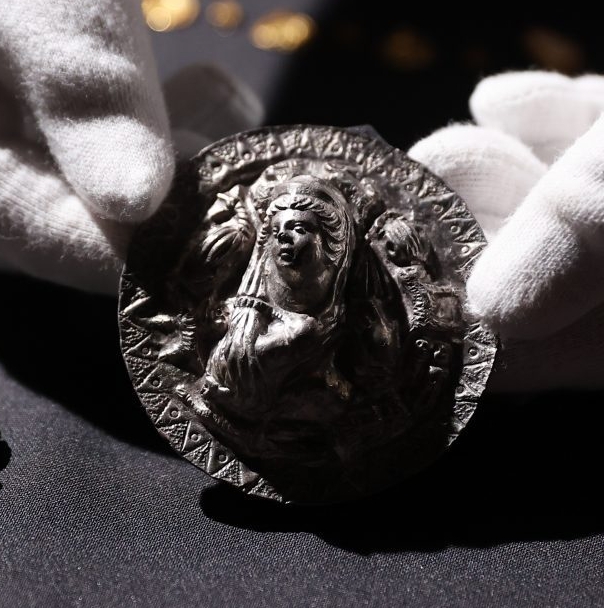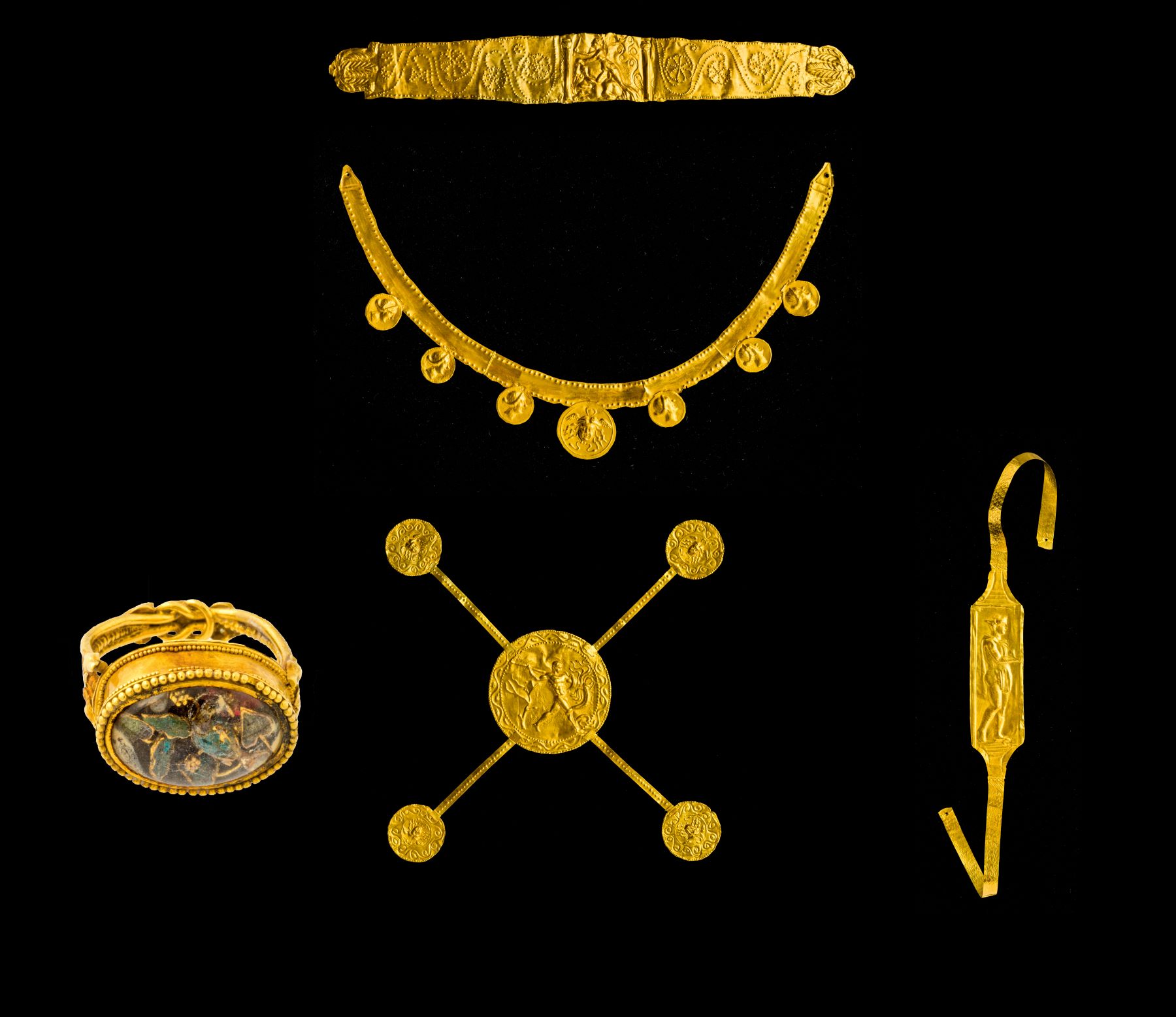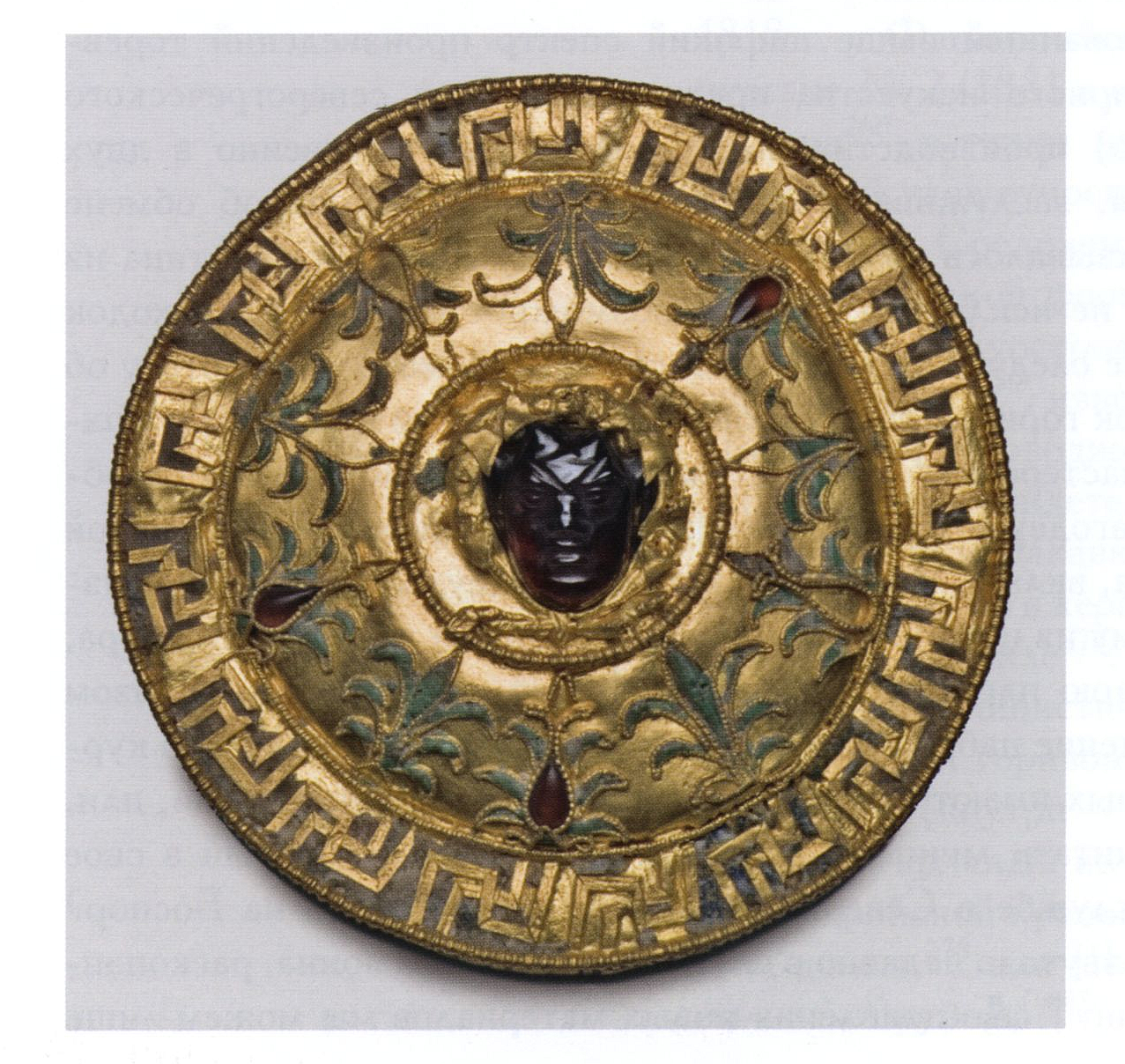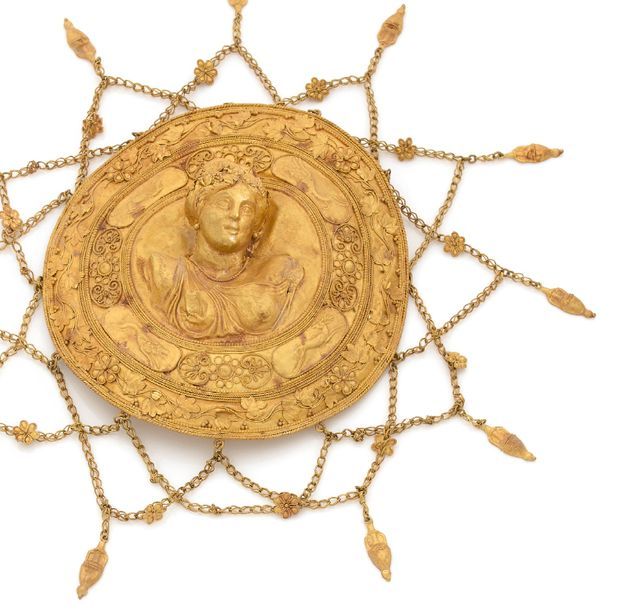The jewelry was found in 1958 during excavations in the Shamsi gorge in Chui region, Kyrgyzstan. There are more than 150 gold, silver and bronze artifacts from the 4th-5th centuries, among them rings, a medallion, bracelets, on-braid and temporal ornaments. Based on the artifacts found, it is believed that the burial belonged to a woman from a rich and noble family, the so-called “Shamsi queen”.

One of the best known grave goods is a mask that covered the face of a deceased woman. It is made of the thinnest gold foil, with the eyes made of carnelian. (20.4 x 15.3 cm; 61.49 g)
The tattoo-like decorations with a tree-like design may represent the trees of life. Decorations were made by puncturing on the reverse and covering with white paint on the obverse. [after J. V. Bellezza]
“The eyes are formed by means of soldered gold tape placed edgewise and an oval cornelian in the center. The nose is made of an additional gold leaf thoroughly soldered to the mask. There is an imitation tattoo on the mask: a stylized tree of life is drawn on the cheeks and the nose. The tattoo was made by means of dotted puncturing with a pointed object, from the inner side of the mask.”
[Atlas of Central Asian Artistic crafts]
photo: © State Historical Museum of Kyrgyzstan


This unusual jewel is made of gold and decorated with amber and garnets. There is a female bust carved of amber in the central medallion, the frame of medallion is inlaid with garnets. It has dimensions: 3.7 x 3.2 cm, weight: 65.52 g.
Necklace-like side parts are connected with hinges, and are terminated by loops. They are decorated with carved leaf-shaped garnets.
It is not known what this jewel actually was, it could have been part of a necklace or a headdress. On one website I found information that this is a chest ornament.
COMPARE with GEORGIA! The “Atlas” mentions the resemblance to Roman cameos
Medallion belongs to the group of artefacts of the Late Roman tradition, of the so-called Style B (Adams 2000, 29, 55, fig. 2); the Mediterranean or Near Eastern workshop; Mediterranean fashion [Mastykova, Anna 2020]

3 – Armaziskhevi (Georgia); 4 – Simleul Silvaniei (Romania; according to Mastykova 2007, fig. 10).
[Mastykova, Anna 2020]

In 1960, the expedition of the National Academy of Sciences found gold, jade jewelry, and clay vessels.
https://sputnik.kg
Made of gold headdress has the form of a skull-cap. It is inlaid with glass or amber and decorated with hanging rustling tubes.
Regardless of its appearance, the diadem is surprisingly light, it weights 60 grams only. It has a diameter 15-17 cm.
Gold temporal and on-braid pendants [see pictures below] were also encrusted with glass or amber, all inlays are missing now unfortunately.
On-braid pendants
Diameters of balls are: 2.3 and 2.5 cm.


Temporal pendants

Except for personal adornments and items of everyday life, steppe burials, both male and female ones, often include horse equipment and weapons also. [Kazanski M., ДРЕВНОСТИ]

After M. Kazanski [Морской Чулек]


Two gold rings

Jade bracelets



SOURCES
- Atlas of Central Asian Artistic crafts and trades. Vol. III Kyrgyzstan; 2002
A. Japarov, E. Sulaimanov, К. Tashbaeva, L. Vedutova https://unesco-iicas.org/book/64
“Most of arts and crafts works reproduced in this book are kept in the Kyrgyz State Historical Museum and in the Archaeological Museum of the Institute of History of the National Academy of Sciences of the Kyrgyz Republic.” - Christopher Baumer, The History of Central Asia: The Age of the Silk Roads (Volume 2)
- Kazanski M., Морской Чулек — Шамси — Аржан Бугузун: миграции степных кочевников в постгуннское время и «княжеская» культура. [Morskoy Chulek – Shamsi – Arzhan Buguzun: migrations of steppe nomads in post-Hunnic times and “princely” culture]
Stratum plus. Archaeology and Cultural Anthropology, Haute École d’Anthropologie, 2020, pp.55-72. https://hal.archives-ouvertes.fr/hal-02988868 - Kazanski M., ДРЕВНОСТИ СТЕПНЫХ КОЧЕВНИКОВ ПОСТГУННСКОГО ВРЕМЕНИ (СЕРЕДИНА V – СЕРЕДИНА VI В.) В ВОСТОЧНОЙ ЕВРОПЕ https://www.academia.edu
- 2015 – Кожемяко П.Н., Кожомбердиев И.К. Катакомбные погребения ущелья Шамси // Археология Центральной Азии: архивные материалы / науч.ред. С.Б.Болелов, В.А.Кольченко. – Т.2. – Самарканд: МИЦАИ, 2015. – с. 130-157 https://www.academia.edu
- Mastykova, Anna 2020. The Neck-Ring Grave in the Cemetery of Klin-Yar and Its Place in the Hierarchy of Privileged Women’s Burials from the Great Migration Period in the North Caucasus. In Slovak Archaeology , vol. LXVIII, no. 1, pp. 69-81. 1335-0102. DOI: https://doi.org/10.31577/slovarch.2020.68.4
- Noel Adams 2000, The development of Early garnet inlaid ornaments. In: C. Bálint (Hrsg.): Kontakte zwischen Iran, Byzanz und der Steppe im 6. – 7. Jahrhundert. Budapest 2000, 13 – 70
- The golden burial mask of Shamsi, John Vincent Bellezza http://www.tibetarchaeology.com/december-2013/
- An article about the exhibition at the State Historical Museum of Kyrgyzstan https://sputnik.kg/
- An article “Шамси- золотая маска Чуйской красавицы” [Shamsi – the golden mask of the Chui beauty]
https://govori.tv/longreads/shamsi/shamsi.html - Сокровища древнего Кыргыстана http://www.juvelinet.ru/process/news.html?id=10440
- Pictures by Alexander Tuzov https://www.vb.kg













